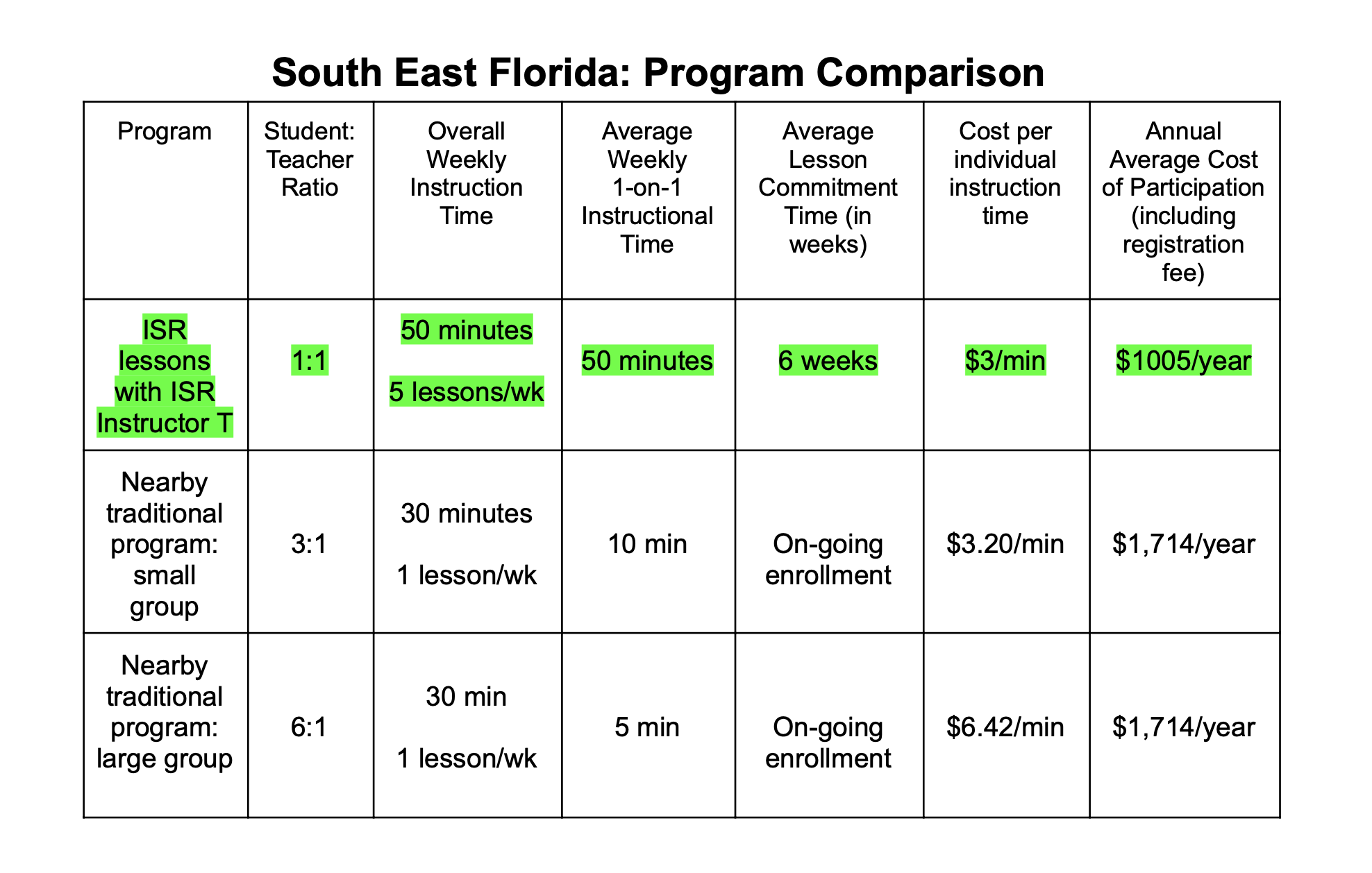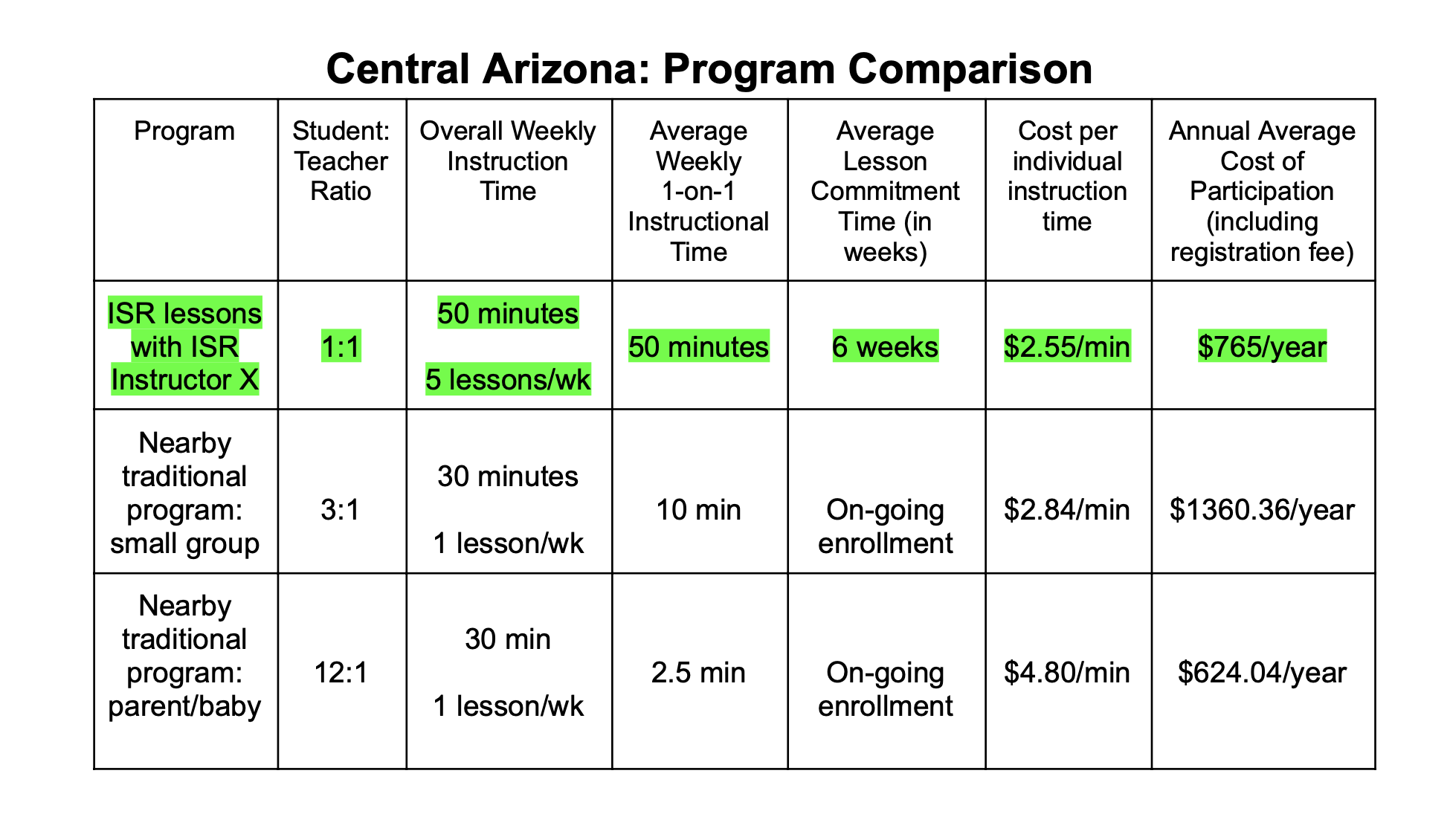
There are a lot of options when it comes to swim instruction for young children. Because ISR is so unique, the truth is that comparing programs becomes nearly impossible for parents. In this series of posts, you’ll find a breakdown of Infant Swimming Resource (ISR) lessons in comparison to typical traditional swim programs to help parents make the most informed decision. This post will focus on the goals and structure of the ISR program in comparison to those from many traditional swim programs.
The goal of ISR lessons is to safely, effectively, and efficiently equip each student with independent self-rescue skills. For babies over 6 months old who are not yet walking, this means the ability to get themselves into a floating position and stay there to rest and breathe until help can get to them. For toddlers who are walking, preschoolers, and young children, ISR teaches the swim-float-swim sequence incorporating both swimming and floating until the child can reach safety at the wall or an edge.
In contrast, many traditional swim programs for children under 4 years of age focus on water acclimation and use flotation devices which provide a false confidence and security for children in the water. The truth is that confidence in that water should be based on competence, not flotation. Lessons in many traditional programs have group settings or use the parent as the instructor using songs and play to build the bond between parent and children. Bonding with your little one in the water can be a wonderful experience; however, the sad truth is that drowning is the number one cause of accidental death for children under the age of 4 and reinforcing the idea that the water is a fun and safe place for little ones without any independent skill can be extremely dangerous.
ISR lessons are structured to optimize the learning process based on the science of how young children learn physical skills and with the highest emphasis possible on safety. This means a one-on-one lesson with a highly trained and Certified ISR Instructor focusing their sole attention on your child. All ISR students are registered and approved for lessons by ISR’s medical team and ISR’s second-to-none safety protocols are embedded within each and every lesson. Each ISR Instructor is trained in behavioral theory so that your child’s lesson is customized to them each and every day.
You’re likely to find traditional program options for small and large group lessons where groups of 3-12 children are in the water with one instructor once per week. This provides extremely limited instructional time for each individual child and, in truth, each child spends a majority of their time on the wall or the steps while the sole instructor’s attention is focused on another child in the lesson. Whether or not you select Infant Swimming Resource for your child, ISR strongly urges all parents to remain present and poolside for any swim program for a young child. The tragic truth is that multiple young children have drowned during traditional group lessons, especially when parents are not allowed to remain present while the lesson takes place.
When learning new physical skills, young children need short and regular intervals of time to learn and practice their new skills. To optimize learning around this truth of behavioral theory, ISR lessons are scheduled for short, daily lessons scheduled five days per week. This schedule allows ISR students to become independently skilled in the water in just a matter or weeks - not months or years - and because the ISR program is customized to each child, there is not a set number of lessons to complete. With consistent attendance, ISR skills can be learned in around six weeks of instruction.
The schedule for traditional swim lessons is typically one session per week. These programs offer a subscription format for lessons because, the truth is, there is no goal for the child to ever “finish” lessons.
Costs will vary depending on your area so we encourage you to inquire with the Certified ISR Instructor near you for specific details. However, in many cases, the truth is that the cost of ISR lessons may initially seem to be quite a bit higher than traditional swim programs. However, once you look at the difference in instructional time - to say nothing of results! - ISR lessons are often less expensive. Because traditional programs charge monthly fees based on on-going lessons that meet once per week, the truth is that you’re often paying for just a few minutes of instructional time every week.
We have prepared two case studies with the cost of ISR lessons in two areas with the cost of nearby traditional programs. Again, ISR urges you to inquire about specific lesson costs in your area as these will vary. These examples are solely to aid in accurate comparisons of costs between programs with different structures.

